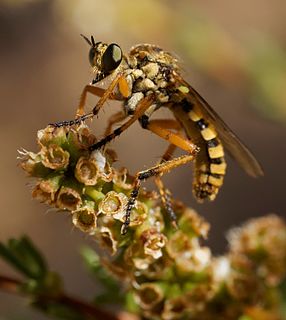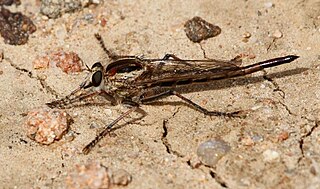| Pegesimallus | |
|---|---|
 | |
| Pegesimallus sp. | |
| Scientific classification | |
| Kingdom: | |
| Phylum: | |
| Class: | |
| Order: | |
| Family: | |
| Subfamily: | |
| Tribe: | |
| Genus: | Pegesimallus |
| Species | |
see text | |
Pegesimallus is a genus of robber flies.
| Pegesimallus | |
|---|---|
 | |
| Pegesimallus sp. | |
| Scientific classification | |
| Kingdom: | |
| Phylum: | |
| Class: | |
| Order: | |
| Family: | |
| Subfamily: | |
| Tribe: | |
| Genus: | Pegesimallus |
| Species | |
see text | |
Pegesimallus is a genus of robber flies.
Africa and Eurasia. [1]
These species spend much of their time perched in the shade on shrubs or grass, where they lie in wait for flying insects. Their prey includes a wide variety of arthropods; Hymenoptera and Diptera predominate. Females oviposit in the surface layer of the soil. [2] [3]
The classification of the species in this genus is difficult for two main reasons: Firstly, many are sexually dimorphic to the extent that females and males of the same species were, for some time, placed in different genera; and secondly, some of the species are so similar that they can only be separated by considering details of the male genitalia. [2]
The genus has been placed in the tribe Megapodini of the subfamily Dasypogoninae. [4] It contains about 54 species, including the following: [2] [1]

The Bombyliidae are a family of flies. Their common name are bee flies or humbleflies. Adults generally feed on nectar and pollen, some being important pollinators. Larvae generally are parasitoids of other insects.

The Asilidae are the robber fly family, also called assassin flies. They are powerfully built, bristly flies with a short, stout proboscis enclosing the sharp, sucking hypopharynx. The name "robber flies" reflects their notoriously aggressive predatory habits; they feed mainly or exclusively on other insects and as a rule they wait in ambush and catch their prey in flight.

The Therevidae are a family of flies of the superfamily Asiloidea commonly known as stiletto flies. The family contains about 1,600 described species worldwide, most diverse in arid and semiarid regions with sandy soils. The larvae are predators of insect larvae in soil.

The Lauxaniidae are a family of acalyptrate flies. They generally are small flies with large compound eyes that often are brightly coloured in life, sometimes with characteristic horizontal stripes, such as in Cestrotus species. Many species have variegated patterns on their wings, but in contrast they generally do not have variegated bodies, except for genera such as Cestrotus, whose camouflage mimics lichens or the texture of granitic rocks.

Dasypogoninae is a subfamily of robber flies in the family Asilidae. There are more than 60 genera and 520 described species in Dasypogoninae.

Platystomatinae is a subfamily of flies (Diptera) in the family Platystomatidae that includes 80 genera, the largest subfamily with at last estimate, c. 900 species globally.

Laphriinae is a subfamily of robber flies in the family Asilidae. There are more than 110 genera and 1,000 described species in Laphriinae. Larvae of the genus Hyperechia are known to grow inside the cells of Xylocopa bees, feeding on their larvae.

Diogmites is a genus of mainly neotropical flies in the family Asilidae or robber flies.

Stenopogoninae is a subfamily of robber flies in the family Asilidae. There are more than 70 genera and 740 described species in Stenopogoninae.

Alcimus is a genus of flies in the family Asilidae, the robber flies and assassin flies. There are about 26 species which are native to the Afrotropics.
Heteropogon is a genus of robber flies in the family Asilidae. There are at least 60 described species in Heteropogon.

Neoitamus is a genus of robber flies in the family Asilidae. There are at least 60 described species in Neoitamus.

Stichopogoninae is a subfamily of robber flies in the family Asilidae. There are about 14 genera and at least 230 described species in Stichopogoninae.

Choerades marginata is a species of robber fly found in Europe.

Hyperechia is a genus of robber flies in the family Asilidae. They appear large, stout and with legs covered in bristles and appear like carpenter bees in the genus Xylocopa and the resemblance is considered as a case of aggressive mimicry, providing protection from predators. The larvae of the fly feed on the larvae of Xylocopa within their cavity nests in wood. They are mainly found in the African and Madagascan region with about 15 species and two species in Asia.
Trichoura is a genus of robber flies in the family Asilidae discovered by Londt in 1994. There are 7 described species in Trichoura. Species in this genus live in tropical biomes across the African continent.
Trapherinae is a subfamily of flies (Diptera) in the family Platystomatidae, which currently includes 11 genera.

Laphyctis is a genus of robberflies restricted to the Afrotropical region. In the past some members were placed in the genus LaphystiaLoew, 1847. Laphyctis has an open R1 cell unlike Laphystia and has long dense macroseta on the distal margin of the male gonocoxite. Most species in the genus are found in dry sandy regions and are active in summer.
 | This article related to members of the fly family Asilidae is a stub. You can help Wikipedia by expanding it. |